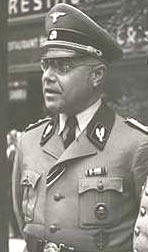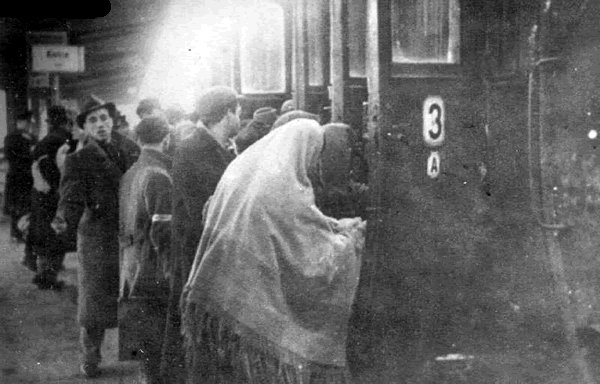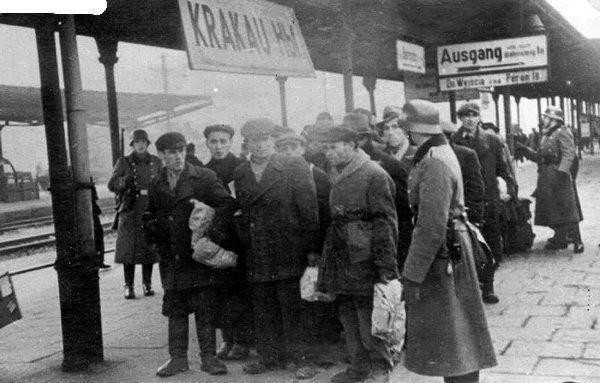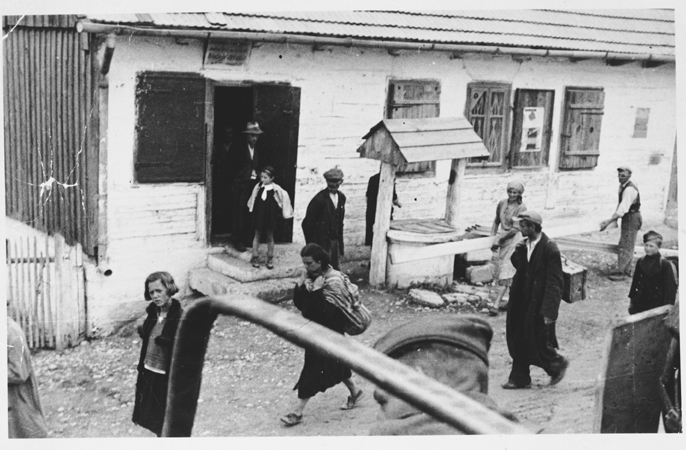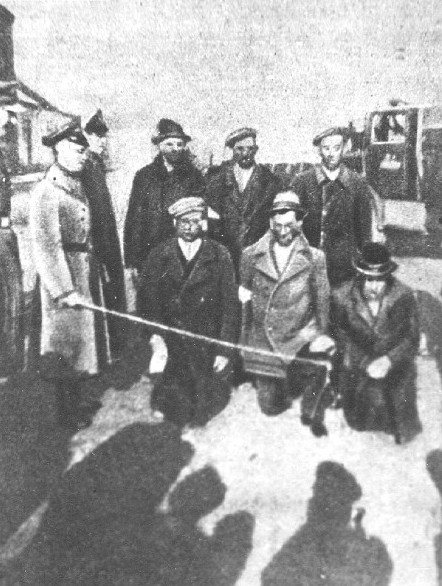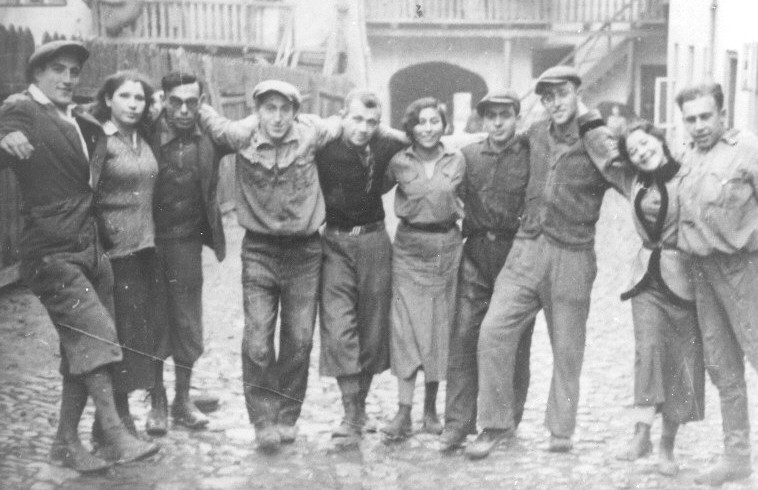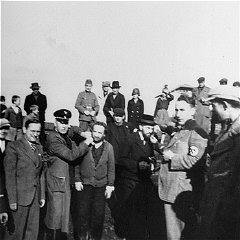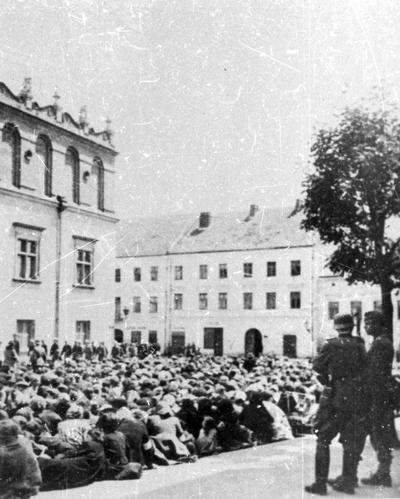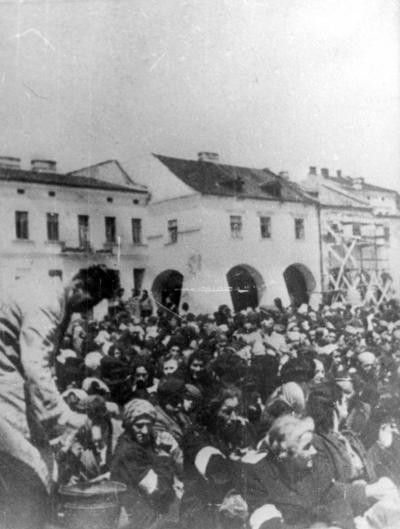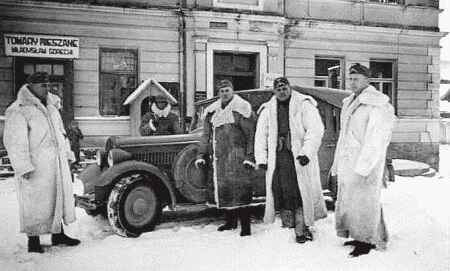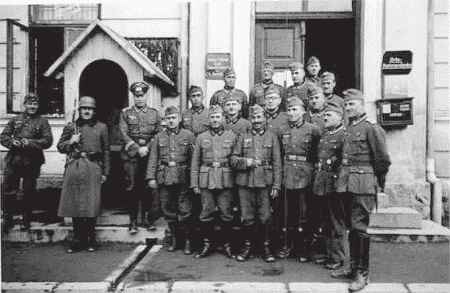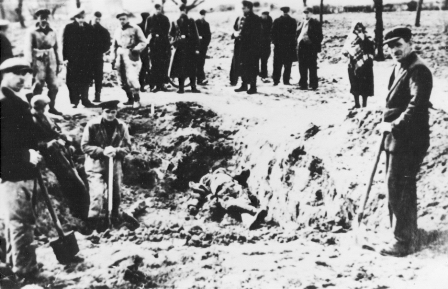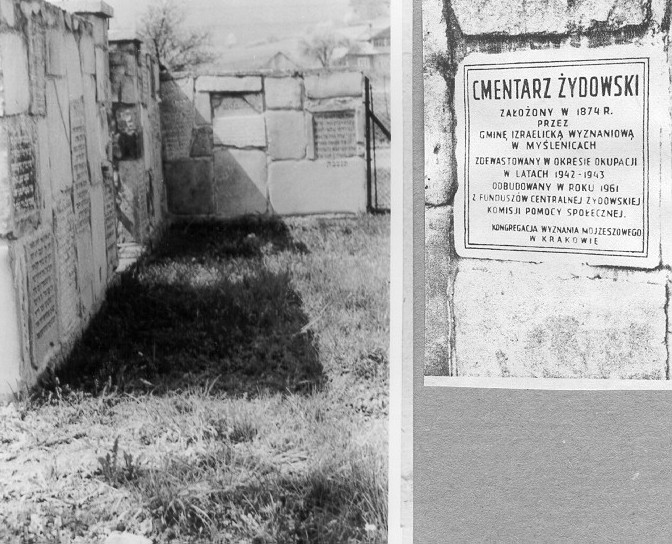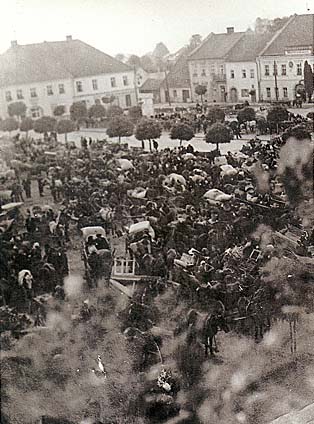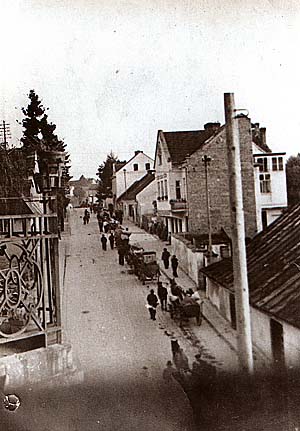Holocaust Education & Archive Research Team |
Ghettos
Krakow Introduction to the Ghettos of the Holocaust
Jewish Ghettos The Judenrat Judenrat Leaders Prominent Jews
| |||||||||
Statement by Josef Mueller Former Commander of the SS Camps in Krakow
Julag 1 in Plaszow - Julag 2 in Prokocim - Julag 3 in Bierzanow
Flensburg 17 June 1960
In the case against Fellenz, it has been necessary to obtain evidence from the witness Mueller which is being taken in the regional court prison.
The witness Mueller described the following:
In the months between January and February 1942, I have performed normal office duties in the head office of the SS und Polizeifuhrer in Krakow. Nothing special happened during that period.
First in March 1942, the exact date I cannot quote, I had to accompany and take part, as a personal bodyguard, the Oberfuhrer Scherner, on a so called Jewish Action.
Altogether, I have participated as an escort, in five such Jewish Actions with various SS Fuhrers. All these incidents happened during the period between March and June 1942.
At the end of June 1942, I have taken over command of the Jewish camps “Judenlager” of Plaszow – Bierzanow – and Prokocim. Following the taking command of these camps, I have no longer been called upon, to escort duties for Jewish Actions.
The Actions mentioned by me happened in the following order:
1) The ghetto in Krakow 2) The ghetto in Tarnow 3) Miechow 4) The ghetto in Tarnow 5) Myslenice – if this place really is so called, I am not quite certain
These Actions happened in the following manner:
1) The Action in the ghetto of Krakow
On a day in March 1942, the exact date I can no longer remember, in the morning, I have been called from my duty office, to the office of the Oberfuhrer Scherner. He immediately informed me that the same day, I am to accompany him as a bodyguard on a journey.
He explained to me, that as a SS- Unterscharfuhrer, I had to know, how to fulfil my assignment. Where we were going, and what assignment was referred to, was not explained to me. I have just received the order, to get ready immediately. This I did.
I entered the car, in front of the duty building, with Scherner. The driver of the car was not known to me then, or now. Besides the driver Scherner and myself there were no other persons in the car. The journey ended fairly quickly, in fact in the Krakow ghetto, there we left the car.
Scherner approached various Gestapo and police officers, and greeted them with a salute. I myself looked around and have noticed that the ghetto was surrounded by police units and was closed. The names of the Gestapo and police Fuhrers, that Scherner greeted, were not then, and are not now, known to me. These gentlemen were not known to me at all.
In the vicinity of those waiting for Scherner, Gestapo and SS officers, stood three Jews. One was in uniform. The uniformed Jew, whom I have later learned to know, as the commander of the Jewish ghetto police. His name was Spierer. Whilst Scherner was still speaking with those officers, an additional company unit of police arrived, this unit marched straight into the ghetto. The commander of this unit reported to Scherner. Following, of which, certain orders were issued, which were not understood by me.
I have kept my distance from Scherner. Up to that point, it has not been explained to me, what was about to happen in the ghetto of Krakow. As a result of the issued orders, the police unit that has just arrived dispersed. The SS police officers in company of Jewish ghetto police went into the buildings.
From there, suddenly, were heard loud screams, windows were being smashed. After a few minutes the first Jews began to emerge from the houses. They were chased by the SS and Jewish police onto the square, where Scherner was standing. This square was surrounded, divided by the police, and used as a assembly point for the Jews.
Chased there, were men, women and children together with the old. This chasing onto that square lasted about two hours. Scherner urged everyone to hurry all the time. In the course of this chase into that square, shots were fired as well. I cannot however state if these shots were fired from within or from outside of the houses.
I have, however, seen dead people, from where I have been standing inside the surrounding area on the square. Scherner himself did not shoot, nor the officers of the Gestapo or the police.
As to the exact place of the events, I can add as follows: the ghetto was not known to me as at that time. The ghetto lay on both sides of a main street, which went from Krakow in the direction of Wieliczka. The entrance and the exit, were distinguished by large gate arches.
During the action I have described, only Jews living in the left sector of the main Wieliczka road were chased out. That was the only part of the ghetto that was surrounded. The square, that I arrived onto with Scherner, and onto which the Jews were chased into, also lay on the Krakow – Wieliczka road.
After the Jews were chased and assembled there, they were marched off under police escort, in the direction of the railway station of Plaszow. Scherner and myself returned to our duty offices in Krakow. We did not go to Plaszow.
On our journey back, I asked Scherner, what is going to happen to these Jews. He explained to me, somewhat casually, that these Jews will be exchanged for German injured servicemen. He rubbed his hands, and declared, “well something has been achieved again.”
During the whole action, apart from Scherner, I have not seen anyone known to me. I have not been required to make any written report about that action. That duty lasted, from departure to our return in our offices about 3 hours.
2) The First Action in Tarnow
About 5-10 days following the above mentioned action, I received again an order, to accompany Scherner as a bodyguard escort. I do not know, when the order was given to me. It is possible that I received the instructions the evening before, to be ready for departure on time the following morning. Again, I have not been told anything further, as to what was the purpose of our journey. Nor have I been told, where we were heading for.
On the day of the Action, we started, that is Scherner, myself and the driver, quite early, I believe around 8.00 am from our offices in Krakow. The name of the driver is unknown to me. Besides the driver, Scherner and myself, there were no other persons there.
This time the journey lasted longer, maybe 1and a half hour’s, we were driving very fast. Finally we arrived into a town, which I was told to be Tarnow. The position of the ghetto in Tarnow, I can no longer recollect.
In the ghetto there was once again a large square. We drove to this square, Scherner alighted there, the driver and myself remained in the car. On the square there were several police officers, I believe that a Fuhrer of the SD, was there as well.
T
he ghetto itself, was visibly, surrounded by police units. On the square were parked a large number of military lorries. A police officer, in a brown uniform, cap and brown riding boots, clearly the rank of a Major, reported to Scherner. Scherner immediately issued several orders, and inspected documents, which were handed to him by Jews. I assume that this Jew belonged to the Jewish council.
Before anything happened, that is before the Police officers went off to their ordered tasks, Scherner entered the car again, and ordered the driver, to head for the SD building in Tarnow. When the car reached the SD building, Scherner stepped out, and entered the building.
The driver and myself remained waiting outside, in the car. That SD building was in a nearby street. Whilst we were waiting, we noticed, that in the main road, the police lorries, which we have seen standing on the ghetto square, were being driven, fully loaded with Jews, out of the town, in fact, in the direction from where we came from, that is, in the direction of Krakow.
After a short while, we noticed, these lorries returning empty. It was simply so that the lorries loaded with Jews, were being driven outwards, and the returning empty vehicles were driven back into the town. It was a continuous round trip.
Having waited there a while, Scherner returned in company of a higher ranking SD Fuhrer than him, from the SD building. Scherner ordered the driver and myself to drive to the German House in Tarnow in order to have our lunch there, and wait there for him.
He himself went into the car of the SD Fuhrer and drove away. Where to I do not know. The driver of Scherner and myself proceeded to the German House. That house was also located, on the earlier mentioned main street. Whilst we were sitting in that German House, we could continue to observe the lorries on their round journeys. We deliberately found a seat next to a window, in order to keep an eye on our vehicle.
Having finished my meal, I have been curious to go into the street, I wanted to know what was happening to these Jews. After a few moments, I stopped a lorry loaded with Jews that was going out of town, and asked the driver if he knew where the SS and Police Leader Scherner could be found. The driver answered in the negative.
I then told him, that I wanted to drive with him for a short distance. We drove a short distance out of town, in the direction of Krakow. A short distance from the end of town, there is a bridge. We drove over that bridge, and immediately behind that bridge, there is a field lane, leading off the road to the right. This lane led into a forest.
We drove into the forest. After about 100 meters the vehicle was stopped. I went out. The tailboard of the lorry was opened. The Jews descended. The entire forest was surrounded by Police. As one entered the forest a little deeper, one came across a large opened grave. The grave was quite deep. The Jews, men, women, the old (no children) had to undress. In that manner they were led into that grave. They had to jump into that grave and lay down there. Down there in that grave there were two men with revolvers (probably c-8 guns).
I assume that these men belonged to the SD. They wore however no uniform jackets. The sleeves of their uniform shirts were rolled up. The Jews were made to lay down in the grave. They were then killed with a shot into the back of the neck, from the pistols of the two armed men there.
Above that grave, there was, as I believe to remember, an ammunition box containing filled ready to use ammunition magazines. I cannot say if these magazines were refilled there on the spot. I do not know either, in what manner the full magazines were passed to the men who were firing them in that grave.
Also over the grave, which I can well recollect, there were barrels of lime. A little further away there were several Jews working who were clearing up the clothing of their tragic comrades and throwing them onto one spot. This clothing was then taken back into town in those lorries. The lime had then to be thrown over the bodies of their comrades, by these Jews working there.
I watched these proceedings only for a short while, I became faint, I then immediately returned on the next vehicle back to Tarnow. Back in Tarnow, I had a drink of alcohol in a small pub. And after that I returned to the German House. There I met the driver again - he sat in the car and slept. After a while, how long that was, I do not know, Scherner returned.
We drove with him back to Krakow. During the journey no conversation took place, at least not about the liquidation of Jews. At the place of execution of the Jews in the forest, I did not see Scherner there. At the whole Action, I did not meet anyone or see anyone that was either known to me then, or in the past.
3) The Action in Miechow
For a while, following the two mentioned events, I had a considerable period of peace from such actions. In the middle of May was the next such escort duty I have been ordered to attend, which was again a Jewish Action.
As from March 1942 these Actions were taking place regularly. I personally, have been, as mentioned, saved from these actions for a considerable period. Scherner, who during that period supervised these Action’s always himself, had found another person to use as an escort. Who that other person was, or were, I cannot say. I believe that he took at one time, a police officer as an escort for himself.
Fellenz as far as I know, did not take part in those duties. He was sitting mostly in the office of the headquarters and dealt with the general day to day business of the SS and police Fuhrer. As far as I have heard, the Actions supervised by Scherner, covered the whole area from the German border all the way to Przemysl on the Russian border. I mean that the Action in Miechow, which I am now about to describe, was the first Action conducted by Fellenz.
The Miechow Action developed as follows:
I arrived to my duty office one day in May, the exact date I cannot establish, in the morning. As usual, at the beginning of the days duties, I stood with my comrades gossiping. Whilst we were standing there like this talking, Fellenz came to me and said casually, “Sepp today you are going with me, Scherner’s orders.”
Fellenz was very familiar with me. I made myself ready for departure. In front of the building we entered into a private vehicle. Besides of myself and Fellenz, with us was the criminal secretary Kunde.
Kunde wore a uniform of a Gestapo official. I already knew Kunde, as he sat in the same office building as myself. Fellenz drove the car himself. Kunde sat in the front on the right of him. I sat in the back of the car. I do not remember the make of the car we were using, I did not take any notice of this, as I have no interest in cars. I am far more interested in dogs and horses.
The journey took us in a northerly direction from Krakow. Where we were going and what undertaking we were about to do, has not been disclosed to me. What I can still remember Fellenz and Kunde entertained themselves discussing all sorts of things during the journey, above all, about music and horses.
Fellenz was very musical, I mean, his wife was a singer. Besides Fellenz was also an excellent horse rider. He has won prizes in competitions on many occasions. Regarding the Action we were going to, and regarding any other Jewish matters, has not been discussed at all, during that journey. The journey also took somewhat longer this time.
How long the journey lasted, I cannot any longer say. But it was at least one hour. I have been shown a map of the then Generalgouvernement and have been asked if the place of Mirchow, is the same as the north of Krakow situated town of Miechow. Both these places must be identically next to one another.
As we approached Miechow which was a sort of a village, we could see the place, from higher ground from the cars window, in the distance the railway line, and finally also on the railway line, a very large lawn. On this lawn there were assembled an unbelievable large number of people. Fellenz noticed this as well, and said to us, “Oh they have assembled them already.”
Because of this we did not drive into the village itself any more, but direct onto the earlier mentioned lawn. There we stopped and we came out of the car. Fellenz ordered me with the words, “Sepp you are to remain here,” that is next to the car. He himself went away with Kunde. As I stood next to the car, I noticed that on that lawn there were about 1,000 – 1,500 Jewish people there, women, men, old and the young, but no children, all of them chased and assembled there.
They were guarded by mixed units of Gendarmarie, SD and other assembled special units. There were also groups of Gestapo and SD people there. Who had the command there, I could not establish. It was very hot that day. As I stood next to our car, I have been begged by the Jews for water. It was above all a woman who was begging me. I called one of the Jewish policemen, who were on duty there as well, and ordered him to fetch some water.
This he refused to do, on the ground that the commanding officer there, has specifically forbidden this. I enquired who was in command there. The answer I received was that it was a man called Bauerlein. Bauerlein was a criminal secretary he I believe was hanged in Poland after the war. I explained to the Jewish policeman, that on my orders he is to bring the water, as I come from a higher service office. The Jew refused to obey the order again, at that I went with the Jew to Bauerlein.
He was together with Fellenz, in the vicinity of the lawn, in a building used by the Jewish council. I explained the matter to Fellenz. Fellenz ordered that water was to be brought there. This was done as ordered. As a person I must add that Fellenz was always very correct in his behaviour. Whenever, he was present, the Jews were not beaten. When such attempts were made, he would step in immediately.
The Jews sat on that lawn until the approach of darkness. They had with them some luggage, and some food. As it became dark, a train arrived. The lawn as mentioned bordered onto a railway line. The train stopped level with the lawn and the Jews were loaded into the goods wagons.
The loading proceeded without any incidents, and was supervised mainly by the Jewish policemen on duty there. Any incidents, either of beating or shooting did not occur. This was the quietest resettlement action, which I attended.
The whole time, until the loading and departure of these people, I have been on that lawn. I have not gone away even once, not even to eat. I have spoken to those Jews. The Jews asked me most of all where they were going. I explained to them, that I did not know this. I really did not know where this transport of Jews, was being taken to in that train.
Note:
This interview started at 9.10am and was interrupted at 12.00 hours for lunch. The interview will resume at 15.00 hours. -15.00 hours Session resumed. The loading began, as stated, as darkness fell. The train itself, went off, as far as I knew to an unknown destination, in complete darkness. The goods wagons of the train were completely closed.
For the guard escort of the train, there was at the end of the train, I must correct myself, in the middle of the train, an additional wagon was provided. Following the departure of the train I went with Fellenz and Kunde in the car back to Krakow. The sitting arrangement in the car was the same as the outward journey. Likewise on the return journey the Action has not been discussed. It so happened, that on the journeys to the places where Actions was to take place, or on the return journeys, the Actions itself were not talked about.
Casually, following the first Action, I asked on the return journey Scherner about the whereabouts of the Jews, and in reply received the stupid answer. At this Action, besides of Fellenz, Kunde and Bauerlein, I have not come across anyone known to me.
4) The Second Action in Tarnow
I mean that this Action took place a few days after the Action in Miechow. I cannot exclude the possibility that this Action could possibly have taken place a few days before Miechow. After reconsideration of the matter, I feel that it was first Miechow and then the second Action in Tarnow took place, which I will now describe.
This Action began, in the same manner as the others. I must have been told in the morning in my office in Krakow that I must escort Fellenz again on this journey. Who brought this order to me, I do not know. It is possible that Fellenz himself called me. We drove off again in a service vehicle. This time the car was driven by a driver. In the front seat next to the driver sat Fellenz. The driver of the car was not known to me. The three of us drove off. First we drove to the outer ring road of Krakow, there on a corner, not far from the Gestapo building, stood Kunde, who was known to me.
He was wearing a uniform of the SD. He joined us in the car. We left Krakow and drove in an easterly direction. This time the journey also lasted somewhat longer. How long it took, I cannot any longer remember. The journey ended however, on the square in Tarnow, which was next to the Tarnow ghetto. On the journey there Kunde sat in the back next to me.
As we arrived on that square next to the Tarnow ghetto, Kunde, Fellenz and myself left the car. The driver on orders from Fellenz drove the car a little way back. On the square I saw many SS Fuhrers and police officers, they stood more or less, in one group, I cannot exclude the possibility that I am referring to local police officers. In the distance various SS and SD people were running about. On the square itself stood several vehicles which were clearly from the police. How many vehicles were there I can no longer state.
Further on the square, I saw many Jews. Several of them belonged to the Jewish ghetto police of Tarnow. Another one was a member of the Jewish council, he was waiting standing with papers. Having left the car Fellenz approached the group of waiting SS Fuhrers and police officers and greeted them. I myself was standing at some distance on some steps. From this position I could see the whole events as described above.
Kunde went away as well, I cannot remember any more where he went to, in any case he was no longer there. As I was waiting there, and as Fellenz was in conversation with that group of officers, vehicles with Waffen- SS troops arrived.
It is possible that I am making a mistake and that those SS troops were already there, as I arrived there with Fellenz. To what unit these Waffen-SS troops belonged to and who was the unit commander I have not established at the time. I can however, remember, that the Waffen-SS unit was about a Company’s strength.
I remember this well, even if I cannot quote this exactly, if the unit arrived there after or before of our arrival. In any case I have seen the SS Company unit, as a unit, still sitting in their vehicles, the Company had about 10 -12 vehicles. How and where the Company commander of the SS unit met up with Fellenz, I can no longer remember.
When for example, I have seen the Company commander reporting to Fellenz, I had to recognise him, and later I have established that I knew him from my service in the No 32 unit of the regular SS in Heidleberg, he was the famous Standartenfuhrer Kleinow, commander of that SS Company. This however, I could not establish there, on that square.
The next recollection, that I have, is that the Jews were marched in groups of about 30, onto that square, from the houses. From there these groups, at the beginning, were loaded into the vehicles and driven away. These vehicles returned after a while empty. Whenever there were no vehicle available on the square, the Jews were made to sit on that square. With the Jews, I am referring again to men, women, the old and the young. These single groups of 30 Jews were brought there by men of the SS Company and guarded by them.
Where this SS company came from at the beginning was not known to me, later on I came across an SS man on the square, I asked him in a countryman’s manner, “Hi friend, what type of heap are you, where do you come from?”
On that he answered that they are from a army training place in Debica. I must further add to have noticed, that the clearing of the houses of the ghetto, was conducted in comparative peaceful manner. I have heard no shooting, nor could I establish any other abuses. At the formation of the groups of 30, I have not seen any Jewish police anymore. These seem to have remained in the houses.
When in my interview of the 14-15 /1/1960, somewhat different version was given by me, it happened, because my recollections came to me somewhat suddenly. At that session, I have not been able to grasp all the facts, as correctly, as today. As a result of my imprisonment I have had ample time to think and recollect everything.
What I have stated today, that is correct. When this statement is compared with all the notes of my previous evidence and is proven to be somewhat different that is because my memory about all the incidents is only now returning. When for example, in my statement of the 14-15 January 1960 I have quoted that the Company commander of the Waffen-SS unit reported to Fellenz, and discussed matters with him, this in the sharpness of my memory is no longer right. I have as stated, not known that Company commander personally, I have however, had to recognise him, due to our acquaintance.
It is also possible that the Company commander was not personally there on that square, and that the unit was led, by the senior rank there, who, at most, had the rank of a Fuhrer. The Company commander may have arrived there later, or he may have been pre-occupied some where else.
With hindsight, to my memory of the various events, I must add, that in any event 18 years have gone by. Of these 18 years I have spent 11 and half years, in Russian prisoner of war detention. The events themselves are remembered by me very well. These I will never be able to forget, not in my whole lifetime.
The smaller details, with time, it is the small matters which I cannot exclude as having mistaken or forgotten. Returning to the Tarnow Action, I have, as stated, stood on that square for some time, and what I have described, I have seen. Fellenz kept himself at some distance from me on that square. The square was very large.
In between, it became lunch time, I felt hunger, I went to Fellenz and requested permission to go for lunch. Fellenz gave the permission. I went to the German House. I informed Fellenz of this as well. Fellenz then told me that he will follow me shortly and that I should reserve and keep a place for him. I went to the German House on my own. As far as I can remember Fellenz did come, a little while after I arrived at the German House.
Kunde and the car driver came as well. I had the impression that they came together, and that they came to the German House in the car. We ate our lunch at one table altogether. Fellenz, Kunde and the driver finished the lunch again quickly. I wanted still to have a beer and asked Fellenz about this, to be able to sit a little while longer.
Fellenz allowed this, he was not so bad. With Scherner I would not have dared to make such a request. Fellenz then reminded me, I should not forget myself. With this he wanted to tell me, not to sit there too long. The groups of Jews that went on foot, or on vehicles from the ghetto of Tarnow, did not pass the German House. Their way led through a different road. Having drunk my beer, I left the German House.
I believe, I have then found a coffee shop, and so around 15.00 hours I returned to that square near the ghetto. Once there I reported to Fellenz. Fellenz was occupied on that square. When in my evidence of the 14/15th January 1960 I said that Fellenz has not been seen by me, then that is not correct. This mistake happened, for reasons as stated before. Today I know exactly that Fellenz was there, on that square near the ghetto.
On my return, and report, Fellenz advised me, that at that moment I was not needed. At that, I saw there, that the Jews, in contrast to the morning, were now being driven off in vehicles as well as being marched off on foot, in groups of 30. The guard escort, was in any case, carried out by the Waffen-SS men from Debica.
As I had nothing to do, I went in that direction where the Jews were being taken to. I must add that the ghetto, or the part of the ghetto, from which the Jews were being driven out of, was surrounded by police units. I mean to say that the whole ghetto has not been surrounded, but only one section. The Tarnow ghetto was very large, I cannot remember, if the ghetto was fenced off with barbed wire.
As I have stated, I went from that square, in that direction, to which the Jews were being taken to. I did more loafing around than walking. I looked around at the houses, I then came across a chapel. This chapel was surrounded by a high wall. I had to change direction somewhat and I have shortly noticed that the wall surrounded a cemetery.
As soon as I came near to that chapel I could hear shooting. They were single shots which were fired from several weapons. The firing was quite intense, but I could establish that they were single shots. I have of course served on the front long enough and could as a result distinguish rifle shots from revolver fire. There, revolvers were being used. The place where the firing was taking place was, as yet, not clear to me.
From that chapel, I walked a while on the street which ran along the side of the wall, which surrounded the cemetery. As I walked along that way, the firing became ever louder. On my way there, I have not been overtaken by any vehicles, or marching Jewish groups.
I have been, as stated, walking only in that direction, in which the Jews were being taken to. The Jews must have been taken there by a route that branched off, the way I was following. I did not take too much notice of this, as I have just been doodling along.
On the way that I was using I came at last to the cemetery entrance gate. The wall there was somewhat set back. As I came to that gate, a lorry came towards me, from the opposite direction. The lorry was fully loaded with Jews. That lorry came of course there by another route the way I came was more or less a footway that lead towards the cemetery. At last I entered the cemetery, the lorry which I came across approaching from the opposite direction, stopped at the gate.
The Jews were offloaded, as I came to that gate, the lorry just drove away on its return journey. I could however see that the driver of the lorry was a member of the Waffen –SS. He must have been from the unit that came from Debica. The lorry came to a stop in such a position that the Jews could only go into the cemetery.
On the cemetery entrance gate I noticed Kleinow. Where I knew him from, I have already described before. Kleinow was wearing the uniform of a SS Fuhrer. The rank insignia indicated that he was a SS-Hauptsturmfuhrer. He was wearing uniform trousers and high boots. On his head he wore a round service hat, with a officers cord. In his hand he was holding a pistol.
What type and what calibre that was, I cannot say. When I stated earlier that Kleinow was standing there with a 08 revolver, this I cannot correctly maintain. Today I can only state that Kleinow was standing there with a revolver in his hand. From the Jews that were alighting from the above mentioned vehicles, some were hesitating. They did not want to enter into the cemetery. They have clearly noticed what was about to happen to them there. Kleinow grabbed the ones that were hesitating, by their chest, and killed them with his revolver, through a shot in the neck.
Immediately as I entered the cemetery I have noticed several bodies already lying there, in the immediate vicinity of Kleinow. There must have been some 8-10 bodies there. I have seen myself as Kleinow killed 2-3 Jews that arrived in those lorries, with shots into their necks.
I continued walking very slowly, further inwards. As the cemetery gate was cleared of the vehicle, I could look deep into the cemetery. I could see there barrels of lime, stacked against the wall next to the chapel. Further, I could see lying there, heaps of clothing. I could also see Jews running about some of them had shovels in their hands. What they were doing with them, I have been unable to establish. Others were busy working at the heap of clothing.
Whether I have seen SS-men on that cemetery I can no longer remember now. I have however heard the firing. Who was actually shooting I could not establish. Anything else I can no longer say, if the subordinates of the Kleinow units were shooting on that cemetery or not. In any event I want to stress that the actual shooting on that cemetery has not been seen by me. I must repeat once again, that on the cemetery and in every case SS /SD and Gestapo people had to be there. But I myself have not seen any of them. It is possible that I have seen a few SS men. On that, I now have no recollection. My thoughts on that cemetery were concentrated completely on the person of Kleinow.
One has to consider sometimes what it means when one suddenly and unexpectedly sees his old SS Standartenfuhrer, and in what circumstances, how he, with his own hands is shooting people. My whole thought that I had on that cemetery in Tarnow was this man Kleinow. This thought would not leave me. The memories of Heidleberg returned once again. All of this completely lead back to the person of Kleinow.
That is why the observation of other matters in the surroundings there, was necessarily somewhat easier. In the forefront of this event stood and remains still today the personality of Kleinow. The impression of him was so stark that even today I cannot state whether there were other members of the SS next to him there. Before the cemetery, in any case, I could only notice and recognise the shots from his revolver.
The impression of the person drove me to such a state that I could not recollect whether and how the Jews shot by Kleinow were taken away. I can only repeat once again that all my thoughts were concentrated on the person of Kleinow and remained suspended in that manner. The surrounding world for me disappeared.
I did not go there and greet Kleinow, I did not even give him a normal military salute, Kleinow, in any case was far too occupied with his own activity. I did not make a mistake with the identity of Kleinow, I am completely certain it was him. I have seen his face from the front, and the side, from a distance of at most 3-5 metres. A mistake in this connection is completely ruled out. I have a good person identity memory. The stature of Kleinow, his face and his whole behaviour, how he moved, were known to me, from my time in Heideleberg.
I can repeat once again that I am absolutely certain that the man that stood at that gate of the cemetery and was shooting the Jews was my SS- Standartenfuhrer Kleinow from Heidelberg. From the cemetery back to that square near the ghetto, I took a different route. I did not want to pass the cemetery again.
The picture of Kleinow would not leave me. I am forced to those memories even today, I must think about this all the time that is at that time, I myself have not killed any Jews. As I returned to that square I reported once again to Fellenz. Fellenz told me that we will be returning to Krakow very shortly. At that point Kunde was not yet on the square. Kunde came shortly afterwards. We then drove, in the car, back to Krakow.
I must repeat once again that I myself did not see Fellenz on the cemetery. I must further state that I cannot verify what Kunde was doing on that day. He had at most the responsibility to seal the Jewish properties that were vacated. Fellenz was clearly the one responsible for the liquidation. I cannot state how many Jews were killed on that day. They were however several hundred. It was not known to me that on the same day, Jews were also loaded onto a train on the railway station. Besides of Fellenz, Kunde and Kleinow on that day, I have met no other persons I knew.
On the journey back the liquidation of Jews has not been discussed. Nor have I mentioned to anyone in the car that I have seen my old Standartenfuhrer from Heidelberg. In the late hours of that evening we were back in Krakow. Following this incident I have never seen Kleinow again. I do not know the whereabouts of him or what happened to him.
5) Action in Myslenice
On the statement incorrectly stated as Michlowice. Whether this place is really called so, or by another similar name today, I cannot confirm. I can in any case remember that on the way there, we drove through Miechow. The place where I call Michlowice (Myslenice) was not far from Miechow. I do remember that this place was within the area under the command of Kriminalkommissar Bauerlein. The Action began as before with the order from Fellenz, in our office building in Krakow, as follows;
“Sepp you are coming with me.” Fellenz liked me. I mean that Fellenz was driving the car himself for this Action. Kunde was also with us, Kunde sat in the front next to Fellenz, I was sitting in the back of the car. This Action took place, as far as I remember, two –three days following the earlier mentioned Tarnow Action. We drove in the car to Myslenice through Miechow.
Myslenice was a small village, which I did not know. A regular ghetto area was not there either. The Jews were concentrated in several joint houses. We drove into the village through a small street and onto a small square, on which there were chestnut trees.
On that square three streets converged, including the one we arrived on. The other two streets, which were leading away from the square formed a letter Y. When one emerged from that square and looked around the houses that were standing there, in description I must state that all the houses to the left and right of that latter Y were standing empty.
Apparently the houses at the top of the letter Y were still inhabited, and as I have had to establish by Jews. A complete hunt was organised for the inhabitants of these houses.
This hunt developed as follows:
We arrived in our car, onto the above described square, which was at the centre of the letter Y. There we came out of the car. So much I can still remember that there were 2 or 3 police officers on the square. I must correct myself, on the square, there was one police officer, one officer of the Gendarmarie and one officer of the so-called Gouverner Sonderdienst.
The names of the people are not known to me, I did not know these people at all. Having left our car we established that the sector of the houses that were still inhabited were surrounded by members of the Gouvernor service. In addition Gestapo people were running about from whom I have learned that they belonged to the unit of Bauerlein. I cannot state if Bauerlein was there himself.
The Gestapo men suddenly run into the Jewish inhabited houses. Simultaneously, firing began into the houses from the men of the SD that were surrounding the area. I must correct myself here, the people of the SD were not shooting into the houses. Mostly it was people from the Gestapo that went into the houses and started shooting there.
The inhabitants attempted to escape, some run into the streets, others onto the roofs. The people that run onto the street or onto the roofs were shot down by members of the SD in the streets or on the roofs. At this the Generalgouverneurs units, tightened the surrounding ring ever tighter. cannot exclude the possibility that the shooting coincided with our arrival on the square. I must add in this case the Jewish council did not appear in order to produce documents. I did however notice several members of the Jewish police.
Whether these originated from that place I have my doubts. I would assume that they were brought there by the units of Bauerlein from Miechow, in order to collect the bodies following the Action. I myself have clearly seen as the escaping Jews from those houses were shot down in the streets and on top of the houses. From the firing that I have heard from the houses later, I must assume that this was the killing of those Jews that were still there.
I have watched these events for some time and then I experienced the following: On the roofs there were now dead people suddenly a Jew appeared on the roof, who was clearly a member of the Jewish police. He had a long pole, with this he was pushing down the dead bodies that were on the roof. As the first body fell from the roof, it became too much for me. I shouted at the Jew on the roof , he should leave this alone. His activity however, was not halted.
On the square soon after our arrival three horse driven wagons arrived, (box-wagons). These wagons were escorted by several Jews, not uniformed. Unusually this group of three wagons, with their small group of Jews was without a guard escort. These people looked Jewish but I cannot exclude the possibility that they were Poles.
The groups of people that arrived in those wagons, collected the bodies lying in the streets, and went away. I did not see these people collecting the bodies from the houses, as well. Where they went to, I do not know. The clearing of the houses no doubt took place, following our departure.
This hunt I had to witness for about 30 minutes from the square, Fellenz who was on the square at the beginning as well, drove away for a short while. He had of course, this I have to establish, the responsibility, and the superior order, over the whole matter. Kunde left us immediately on our arrival on the square, and remained with the people of the Gestapo. I assume that he was sealing the houses. I do not know, if Kunde participated in the shooting. At no Action have I seen Fellenz, or Kunde actually shooting.
I must mention this that at the matter of closure and surrounding that was mainly conducted by the people of the SD, and police people also participated. I assume that in this Action 200- 300 people, have lost their lives, I estimate that number from the number of bodies that were taken away. At the time I have been there, and witnessed the whole event, I have seen no living Jewish people that survived and left the place.
I have been asked as to when we left Krakow for this Action, it could have been before, or after lunch. We were in Myslenic one to one and a half hours. From the whole events in that place I must assume that Bauerlein was there himself, he was famous for such Actions.
The hunting of human beings, in that manner, were not to the liking of Fellenz. Fellenz was however a rank higher than Bauerlein. In any event it was so that the superior officer of Fellenz, Oberfuhrer Scherner was more in favour of Bauerlein, as he loved such behaviour.
From Fellenz I had the impression that he was not impressed by these events, on the contrary he was depressed. I believe to remember that immediately on the return of Fellenz, Kunde suggested to him that we drive away.
Kunde agreed and replied that he had a nose-full, that he will return a day or two later and seal the houses. Fellenz agreed to this suggestion. We drove back to Krakow. As we drove off, the shooting was already at an end. The bodies were not transported away for some time. It is possible that at our departure, there was a small pause in the shooting.
We returned to Krakow after office duty hours, I know this because we did not drive to our duty offices any more. I left the car in the town. Again at this Action, apart of Fellenz and Kunde, I have not met or seen any persons that were known to me. I remember however that the special commander of the unit of SD that he was leading, I have seen him now and again in the casino in Krakow. What was his name, and where he came from, I do not know. I would be able to recognise him from a photo even today.
On the return drive from Myslenic to Krakow, that was the only time, Fellenz, Kunde and myself discussed the events of the day. We all agreed that we had our mouthful of it. Kunde said that he will not go to an Action of that type again. Fellenz replied that he would rather volunteer to go to the front, he would not want to experience such events again.
As a result of this incident something must have happened between Fellenz and Scherner. At least it was that we, that is Fellenz, Kunde and myself, several weeks later had to leave the positions we had. Fellenz was transferred from Krakow. I mean he went to the front. Kunde was appointed to the position of administrator of the ghetto in Krakow. I myself have been appointed to administer 3 Jewish camps in Krakow. That is all that I can say about the 5 Actions. I must repeat once again that I have made every effort to my best knowledge to say only the clear truth.
These events, as such, stand even now clearly before my eyes. I must however repeat that within the passing of time, the duration of events and various experiences connected with these Actions, some mistakes in my statements may have occurred. These mistakes do not affect the Actions as such rather at most, the most important single factors. The killing of people stand to this day before my eyes.
I would be grateful if I could be excused and spared from any further interviews on these matters. My nerves are almost at an end. I must point out that in the prison of Mosbach, I have written a factual report, this report is deposited with the authorities in Mosbach.
I would assume the authorities in Flensburg will obtain a copy of this report from Mosbach. I would add that in connection with my private life occupation at my home in Mosbach, I have additional documents - these if necessary can be accessed. Finally I mention once again that my present statements, if they differ from any previous statements of mine, are the correct ones. As I have now had sufficient time to think about everything.
I request also today and would be obliged that this is respected, that the whole statement be allowed for me to be read again, or read to me. I have listened to the dictation of the officials carefully and reported my observations immediately. These wishes were taken notice of. Everything is written down as I have wished.
I confirm this report as correct with my signature.
Signed;
J. Mueller Session completed at 20.15 hours.
Translation by Mark Goldfinger, a former inmate of the SS camps in Krakow commanded by Mueller.
Translators Notes:
1) The place referred to as Miechow, the lawn mentioned is actually situated in a small case called Slomniki, not far from Miechow. 2) The place referred to as Michlowice is in fact Myslenic, there is no such place as Michlowice, nor is it shown on any maps inspected by me.
Authors Notes:
1) Scherner’s office was located in 4 Oleander Street Krakow, formerly a Secondary School. 2) The Jewish commander of the Jewish Police in Krakow’s correct name was Symche Spira. 3) The Assembly point for the Jews of Krakow was the Zgody Square. 4) The first mass deportation of the Jews of Krakow to Belzec took place from the 4th June 1942. Thus the witness is stating the incorrect date, it was in June 1942, further confirmed by his statement re the Tarnow Action taking place 5- 10 days after Krakow. The first Action took place in Tarnow 11th -18th June 1942. Those Jews not murdered locally went to the gas chambers at Belzec. 5) The forest outside Tarnow where Jews were killed was called Buczyna in Zbylitowska – Gora village. 6) The Deutsches Haus (German House) was located at Mickiewicza 4 a Theatre Building. 7) The deportations of the Jews from Miechow to Belzec took place on the 7th September 1942. 8) The second Action in Tarnow took place during September 1942. 9) The murders of the Jews in the Jewish cemetery took place in both Actions, the murder described as the Second Action, is also stated by the witness as taking place during the first Aktion in June 1942. 10) The deportations from Myslenic to Belzec took place between 25-30 August 1942. 11) Virtually every date mentioned by the witness would appear to be incorrect, but the content of the statements are correct, and have been verified by other eye witness statements, in the Authors private archive.
12) SS- Sturmbannfuhrer Martin Fellenz was Commander Security Police Krakow – West Galicia. He conducted five Aktions against Jews in 1942-1943 involving 40,000 people. He was arrested June 1960 charged at Flensburg in November 1962 and sentenced January 1963 to four years imprisonment, and was immediately released.
Adam Bartosz ( Director Muzeum Okregowego Tarnow) Notes:
1) The large square by the Jewish ghetto was known as the Magdeburg Platz 2) The bridge is over the Biala River circa 3km from the Deutsches Haus 3) The execution field was circa 4km behind the bridge 4) The chapel was in fact a burial house 5) The street by the Jewish cemetery was Widok Str. 6) The Jews were taken along Szpitalna Str which led to the cemetery gates
Sources:
Holocaust Historical Society The Cracow Ghetto published by The Historical Museum of the City of Krakow Belzec, Sobibor Treblinka by Yitzhak Arad, published by Indiana University Press 1987 Adam Bartosz – Muzeum Okregowego Tarnow
Special thanks to:
Mark Goldfinger Robin O’Neil Paul Kubis Tarnow Tourist Information Lukasz Biedka
Copyright Chris Webb, & Carmelo Lisciotto H.E.A.R.T 2008
|
